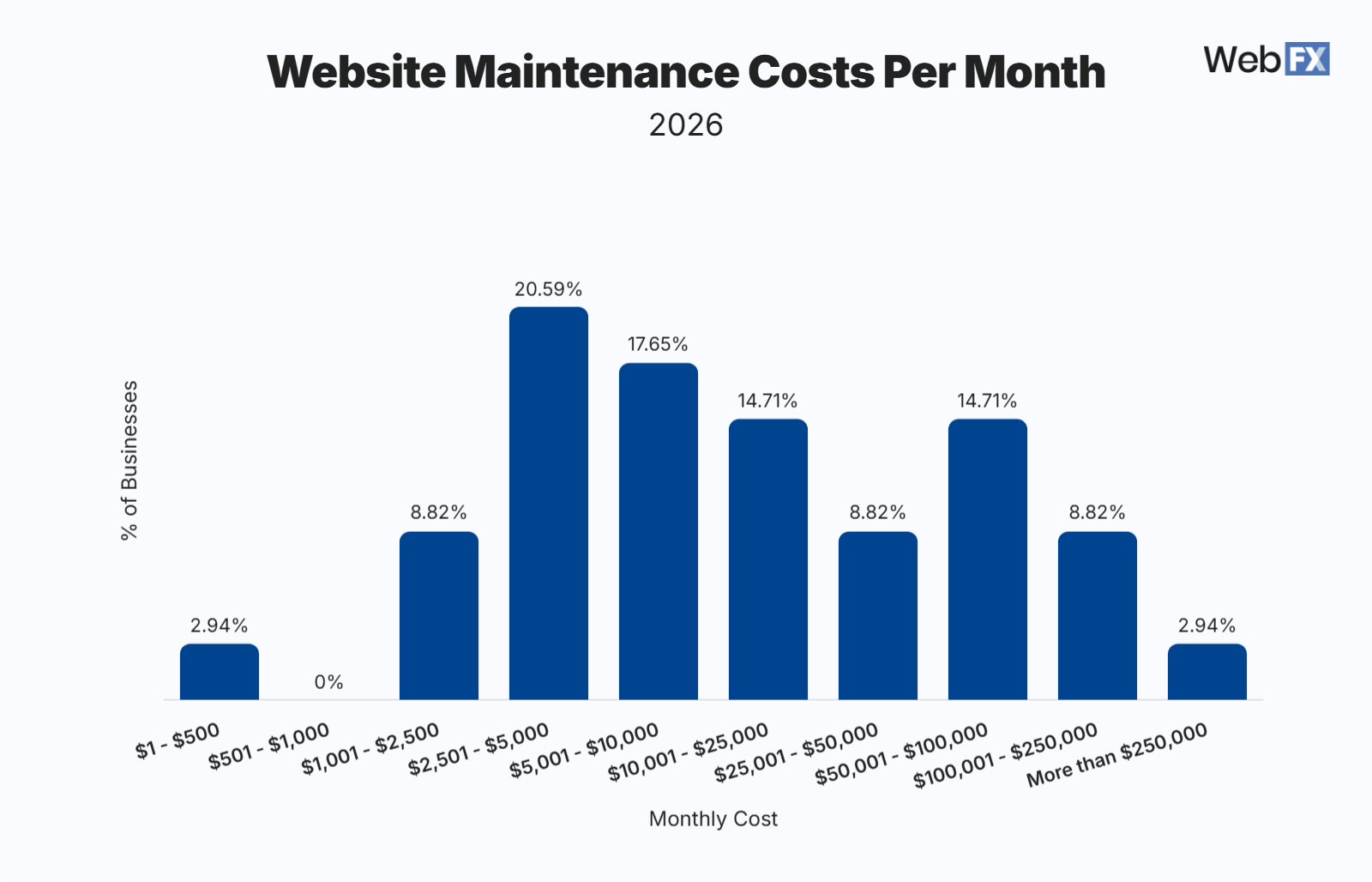2025 Website Maintenance Pricing: How Much Should You Pay?
Last Updated: December 19, 2025
Website maintenance pricing depends on several factors, including your site’s size and your business’s industry. Typically, website maintenance costs $3600 – $50,000. Keep reading to learn more about the average cost for website maintenance!WebFX helps companies like yours reach their business goals.
See Case Study“WebFX has always worked hard to make sure that we’re getting what we need out of the partnership, not just what may seem like the best result.”
An Inside Look at WebFX Web Maintenance Pricing
🔒 Real-time monitoring and firewall protection No matter the scope of your web maintenance needs, you’ll get the support you need to keep your site secure and up-to-date, and ensure your operations run smoothly.
WebFX Expertise
Highlights
📞 Urgent, priority support if website is down or hacked
💻 Additional hours for proactive updates
📈 Website performance, infrastructure, and UX reports
Join the 1,450+ businesses trusting WebFX to keep operations running and stay secure with website maintenance
Too many agencies take a copy-and-paste approach to web maintenance. That’s not our style.
Monthly Website Maintenance Pricing
| Features | WordPress | Enterprise WordPress & WooCommerce |
|---|---|---|
| Recommended for: | WordPress sites 500 or less pages | WordPress sites 500+ pages |
| Primarily static content | WooCommerce | |
| Custom & dynamic functionality | ||
| Website Updates M-F 8a-5p EST | ||
| UX Design, Website Maintenance, Project Management, Visitor & UX Analysis, Client Support, Web Development & Web Infrastructure Hours | Additional cost: $150/hour | Additional cost: $150/hour |
| WordPress Quarterly Upgrades/Security Patches | ($150/hour billed in .5 hour increments for code rewrites/fixes to source or website frontend impacted by security patch updates) | |
| Enterprise WordPress & WooCommerce Quarterly Upgrades/Security Patches | ($150/hour billed in .5 hour increments for code rewrites/fixes to source or website frontend impacted by security patch updates) | |
| Daily Security Scan | ||
| Daily full-site backup and storage at 3rd party location (for easy restore) | ||
| Urgent Support/Restore if Website is Hacked | ||
| If 1 business day turnaround is requested | $250/hour | $250/hour |
| Monthly Investment | $350 | $550 |
| Need more information? Call Us: 888-601-5359 | GET STARTED | GET STARTED |
Hourly Website Maintenance Pricing
| Features | Design & Support | Internet Marketing | Development |
|---|---|---|---|
| Billing | Billed in 30-min. increments | Billed in 30-min. increments | Billed in 30-min. increments |
| Minimum Service Request | 1 hour | 1 hour | 1.5 hours |
| Online Customer Support System | |||
| Rates | $150/hour | $150/hour | $150/hour |
| Need more information? Call Us: 888-601-5359 | GET STARTED | GET STARTED | GET STARTED |
Get custom website maintenance pricing for your website
Now that you know the average cost for website maintenance, it’s time to find a provider in your budget.
If you’re looking for website maintenance services from a trusted provider, WebFX is a leading choice. With more than 29 years of experience, plus an award-winning team of designers and web developers, we can ensure your website performs for your business.
Plus, as a full-service digital marketing agency, we can help optimize your website to deliver even better results. With SEO, conversion rate optimization (CRO), and website redesign services, we can help you earn more from the web — even if you operate offline.
Learn why 91% of our clients stick with us by contacting us online today.
If you need immediate assistance, call us at 888-601-5359 to chat with a strategist now!
Meet WebFX
A world-class digital marketing agency with thousands of reviews applauding our transparency.


Related Resources
FAQs about website maintenance costs
If you have questions about website maintenance, check out this helpful FAQ from our developers!
What is website maintenance?
Website maintenance is a routine process of inspecting and updating your website to industry standards, as well as company changes. With website maintenance, for example, you ensure your site features the latest prices for your services or images of your product.
You also make sure your website adheres to industry standards for security and data protection. This process is critical since more businesses, even those that operate offline, support online transactions. For instance, a heating and oil company may allow shoppers to pay their bill online.
Like maintaining your vehicle, website maintenance is essential to keep your business running smoothly.
Why should I invest in website maintenance?
When it comes to website maintenance, the biggest question people ask is why — Why do I need to invest in website maintenance anyway?
Think of your website like a car. It’s good to do routine maintenance on your car to ensure everything’s running properly and that your car is safe to drive. If you ignore the routine maintenance of your car, it may break down and lead to costly repairs.
Your website is no different. Doing regular maintenance ensures your website runs smoothly and, if there are any problems, you fix any issues fast. It ensures you avoid bigger problems in the future, too.
Here’s a great example: Imagine you have a WordPress website and you’re using a security plugin to protect shoppers’ information. You decide not to do regular website maintenance, which means you don’t update your plugin, and you don’t check to make sure it’s in working order.
Three months later, you find out that a hacker was able to take advantage of your lack of maintenance, and now all your customers’ information has been stolen. Your reputation is damaged, and now you have to spend all your time trying to recover.
Regular website maintenance is an investment, but it’s a worthwhile investment to prevent larger problems and costs in the future.
Why pay for website maintenance?
Companies may invest in third-party website maintenance services for a variety of reasons, including:
- Small in-house development team
- High costs for internal management
- Limited resources for in-house management
In most cases, it makes sense for businesses to partner with a service provider that features a dedicated team of developers, like WebFX. That way, you get skilled experts maintaining your website, rather than having to spend the time learning how to do it yourself.
Should I maintain my website myself or hire a website maintenance professional?
Many businesses will try to handle their website maintenance in-house in an effort to cut costs. While it’s certainly an option, it may not be the best course of action. Your website’s maintenance is crucial to maintaining your security and keeping your website functional.
If you don’t have experience with website maintenance, you run the risk of making problems worse or feeling frustrated that you don’t know how to fix a problem. Relying on professionals can make website maintenance headache-free, so you can focus on more pressing business tasks.
So, consider your answers to these questions to determine if you should handle website maintenance in-house or partner with an agency:
- Do you have the time to dedicate to maintaining your website?
- Do you have the resources to maintain your website?
- Do you have website maintenance knowledge?
- Do you feel confident in your ability to troubleshoot issues as they arise?
If you answered “no” to one or more of these, hiring a website maintenance company may be the best option.
How often should a website have maintenance?
A website should receive maintenance at least once a year, which generally includes:
- Domain name, SSL certificate, and website hosting renewal
- CMS updates and security patches
- Ecommerce system updates
Now that website maintenance includes more than domain name renewals and website hosting updates, it’s becoming critical for companies to maintain their website on a more frequent basis. That’s why many service providers offer monthly plans.
With a monthly plan, your company’s website receives regular updates, as well as fixes to bugs, content, and images. It’s a proactive approach that helps your site remain accurate and provide users with the latest information on your products, services, and accomplishments.
Why do website maintenance packages pricing vary so much?
Prices for website maintenance have a wide range due to several factors, including:
- Your website’s size
- Your website’s complexity
- Your service provider’s experience
- Your service provider’s resources
- Your website maintenance service selection
Many providers will give you a one-size-fits-all plan, which can lead to you paying for things you don’t need. Some agencies will offer a lot in their website maintenance packages, which will cost more, while others only offer basic maintenance tasks, which costs less.
The cost will always vary depending upon what’s in the service, who’s providing it, and how often you’re opting for maintenance.
How much does monthly website maintenance cost?
The average price for monthly website maintenance is $20 to $5000 per month. Depending on your business and website, you may spend a different amount. That’s why it’s helpful to use this monthly average as a reference rather than a standard.
To put the variance of monthly website maintenance pricing in perspective, think about the maintenance for a massive and complex ecommerce site like Target. Due to the size and complexity of Target, it makes sense that Target would exceed this monthly average.
In comparison, a local coffee shop may have website maintenance fees of less than $35 per month. They have a small, simple site without ecommerce functionality. Plus, they get their SSL certificate for free. Those features simplify their upkeep tasks and reduce their costs.
If you’re searching for an accurate estimate for monthly website maintenance costs, get started by looking at your current expenses. You can find what you pay for your domain name and website hosting, for example, as well as if you have any additional CMS fees.
How much does website maintenance cost per year?
The average cost for website maintenance each year is $300 to $60,000. While you may pay for some services on a monthly basis like tech support and website updates, other website maintenance fees require an annual payment.
A few examples of services that usually require upfront payment for the year include:
- Domain name
- SSL certificate
- Website hosting
When you build your website maintenance budget, your team should research which services mandate upfront payment for the year. This approach allows your department to secure these funds immediately versus over time.
If you’re looking to partner with a service provider for website maintenance, many operate on a per-month pricing plan. WebFX, for example, offers monthly service plans to give your company and your team the flexibility and convenience of modifying your package.
Should I outsource or DIY my website maintenance?
While you can lower your website maintenance costs by managing and maintaining your site in-house, there are some downsides. You’ll need to have the time, for example, as well as the development background to maintain your site successfully.
In comparison, outsourcing increases your web maintenance costs. It does save you time, though, as well as connects you with an experienced developer or development team. You can outsource your website maintenance to freelancers, contractors, or even agencies like WebFX.
Unless you (or your company) has the experience and time to maintain your website in-house, it’s often better to outsource the task. That way, you ensure your site remains secure, accessible, and functional year-round.
How do I decide which website maintenance provider is best?
When looking for the right website maintenance provider, it’s important to know what to look for in an agency or freelancer.
Even though pricing is a critical factor, you shouldn’t use it as the only deciding factor.
Fixating on website maintenance pricing can result in your company partnering with an inexperienced, unresponsive provider. It may feel like you’re saving money now, but it’ll end up costing you more down the line. That’s why businesses need to look at price as a component rather than as a decision maker when comparing service providers.
Here are some others factors to consider:
- Experience of the agency
- Whether they offer one-size-fits-all or custom plans
- Responsiveness of the agency (how do they communicate with you?)
- Size of the team
Take all of these factors into consideration when trying to choose a website maintenance provider to ensure you get the best one for your business.








